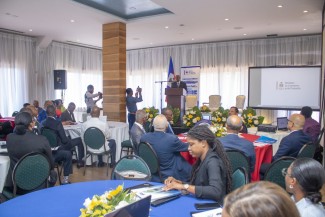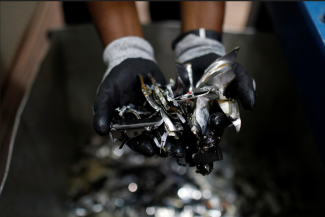More collaboration, studies needed to boost developing country agri-food exports
Pesticides are a hot topic when it comes to the intersection of agriculture, trade and food security.
Pesticides often cause trade issues for developing country agri-food exports, including tropical fruits and vegetables. The first problem is that very few Maximum Residue Limits (MRLs) exist for these "minor-use" crops that are so important for small-scale farmers and developing countries. The second problem is that even when MRLs exist, they often differ from international food safety standards set by the FAO/WHO Codex Alimentarius Commission, or Codex. When importing countries set their own lower limits, it greatly increases the costs and complexity of trade.

There is frequent attention to trade issues linked to pesticide MRLs in the WTO's Committee on Sanitary and Phytosanitary (SPS) Measures. From 2000 to 2018, pesticide MRLs were the focus of approximately 20% of all SPS notifications by WTO Members

Caption: Created in 1963, Codex has developed hundreds of internationally recognized standards, guidelines and codes, and defined thousands of permitted levels of additives, contaminants and chemical residues in food, including MRLs for pesticides.
Pesticides, agriculture, trade and health
Farmers worldwide rely on pesticides to protect their crops against plant pests and increase yields, which is essential for livelihoods and food security. With climate change leading to new and evolving pest risks and uncertainties, these products are needed to respond to existing and new pest risks, like the destructive Fall Armyworm which reached West Africa in 2016.
Consumers are concerned about the human health and broader environmental impacts of pesticide use. In developing countries, where farmers often only have access to older-generation pesticides, lack adequate personal protective equipment, are unable to read or understand labels with safety instructions, risks related to improper pesticide handling and use are even greater.
Faced with inadequate infrastructure and resources, pesticides also sometimes end up in the most unlikely of places. A regional total diet study in Cameroon, Benin, Mali and Nigeria – led by FAO with government authorities, WHO and the Pasteur Institute, with Standards and Trade Development Facility (STDF) funding – uncovered high concentrations of pesticide residues in smoked fish consumed in Mali and traded regionally. The study used contamination data from foodstuffs cross-referenced with data on consumers from the target population. It found that, lacking proper storage facilities, small-scale traders turned to a pesticide called chlorpyrifos to keep insects away from their smoked fish at market stands, unknowingly creating risks to human health.

Some crops are considered too "minor" by pesticide companies to warrant investment in expensive field trials, registration and submission of data packages to Codex.
The opportunities: Closing pesticide residue data gaps
Public-private collaboration works to expand residue programmes and boost compliance with Codex standards
Second and third-generation pesticides are being phased out by developed countries. Yet farmers in Africa have little choice but to use older chemicals because there are few Codex MRLs for newer, less toxic pesticides for their specialty crops. Residue data to establish MRLs and support new product registrations are very rarely generated in developing countries because of increased costs and expected lower profit margins.
Under an STDF project in Ghana, Kenya, Senegal, Tanzania and Uganda, governments partnered with multinational pesticide manufacturer Corteva (Dow), industry association CropLife International, farmers and international partners on a residue study on sulfoxaflor, a new-generation pesticide used on mangoes, an export crop that many small-scale farmers in West Africa depend on for their livelihoods.
The study was a major achievement for everyone involved. Field trials had to be set up and implemented to monitor sulfoxaflor's use. Scientists and regulators were trained to generate, review and interpret pesticide residue data. Unexpected challenges linked to limited laboratory infrastructure in Africa were overcome. For instance, when freezers broke down, ruining samples and requiring field trials to be repeated.
Despite the hurdles, this collaborative approach was ultimately successful. The project partners completed the residue study, with the full data package for sulfoxafor/mango submitted to Codex and a new MRL expected in 2022. In Tanzania and Uganda, the private sector registered the new lower-risk pesticide in 2019 and 2020 respectively, with other countries in the process of doing so. The experience paved the way to the adoption of new regional guidelines to harmonise pesticide registration processes in the East African Community, with the Economic Community of West African States (ECOWAS) keen to replicate the experience.
On the ground, access to sulfoxafor will help farmers control fruit flies more effectively and meet international standards, facilitating safe trade, and bringing benefits for agricultural productivity, environmental health and consumer safety.
Getting the incentives right
Experiences with this regional MRL project in Africa, as well as parallel STDF-funded projects in Asia and Latin America, highlighted the value of public-private partnerships to plug data gaps, generate cost savings and improve results. Pooling data also led to more robust data sets that reflected geographic and climatic diversity. An external evaluation highlighted how the projects catalyzed public-private collaboration to increase knowledge and capacity on pesticide MRLs for the benefit of developing countries.
But the experiences also revealed what happens when the incentives for private sector engagement are weak, especially in the poorest countries that stand to benefit most. Compared to Asia and Latin America, where the incentives were stronger for multinationals to partner with government authorities on residue studies, in Africa it was much more difficult to get and keep pesticide companies on board, alongside issues with access to pesticides, expertise and other resources.
Need for more sustainable solutions to address lab capacity gaps
In developing and least developed countries, innovative and sustainable solutions are urgently required to address laboratory capacity gaps. Sometimes, the problem is simply a lack of basic lab infrastructure and equipment. At other times, sophisticated equipment may exist, but there are too few skilled technicians to operate the equipment or a budget is not available for reagents and supplies needed to run diagnostic tests.
Another challenge is the need for different types of expertise for different types of tests. Regional centers of excellence that share expertise and resources have been proposed as a more sustainable solution. For instance, an external evaluation of an STDF project to reduce pesticide residues in cocoa recommended ECOWAS to develop a pilot regional "center of expertise" specialized in pesticide residue monitoring to promote economies of scale. Developing lab infrastructure to support food control systems – including regional reference testing laboratories – is a key part of the African Union's SPS Policy Framework for Africa. More public-private collaboration can further improve results and sustainability.
What is missing is the financing needed to set up and roll out these initiatives.

Stronger food safety systems are key for public health and food security
Consultations for the UN Food Systems Summit in 2021 have highlighted the need for increased access to safe, nutritious and affordable food, and the vital role of safe trade to achieve sustainable economic growth, poverty reduction and food security.
Africa has the world’s highest incidences of foodborne illness, claiming 137,000 lives a year and causing 91 million cases of sickness, according to the WHO. With the African Continental Free Trade Agreement (AfCTFA) and the rapid growth of regional agri-food trade, much more investment is needed to improve food safety in the public and private sector.
Making real progress will depend on the effective engagement of diverse stakeholders across agriculture, health, environment, trade and development, and simultaneously tackling capacity gaps and inter-related challenges that exist across multiple areas. Increased action on pesticide residues and lab capacity development is just part of the solution.
-----------------
Find out more:
- Human dietary exposure to chemicals in sub-Saharan Africa: Safety assessment through a total diet study, Article published in The Lancet, July 2020
- How safe is Africa's food? FAO film illustrating how the STDF-supported regional Total Diet Study helped to inform food safety decision-making, empowering governments to target resources most effectively.
- Building on the results of the STDF regional MRL projects, the Global Minor Use Foundation was set up to generate global, regional or national residue data to establish new MRLs, and expand low-risk pesticide options for tropical produce.
- Supporting Africa, Asia and Latin America to meet pesticide standards for export, STDF project webpages and results story
©STDF/José Carlos Alexandre
If you would like to reuse any material published here, please let us know by sending an email to EIF Communications: eifcommunications@wto.org.



